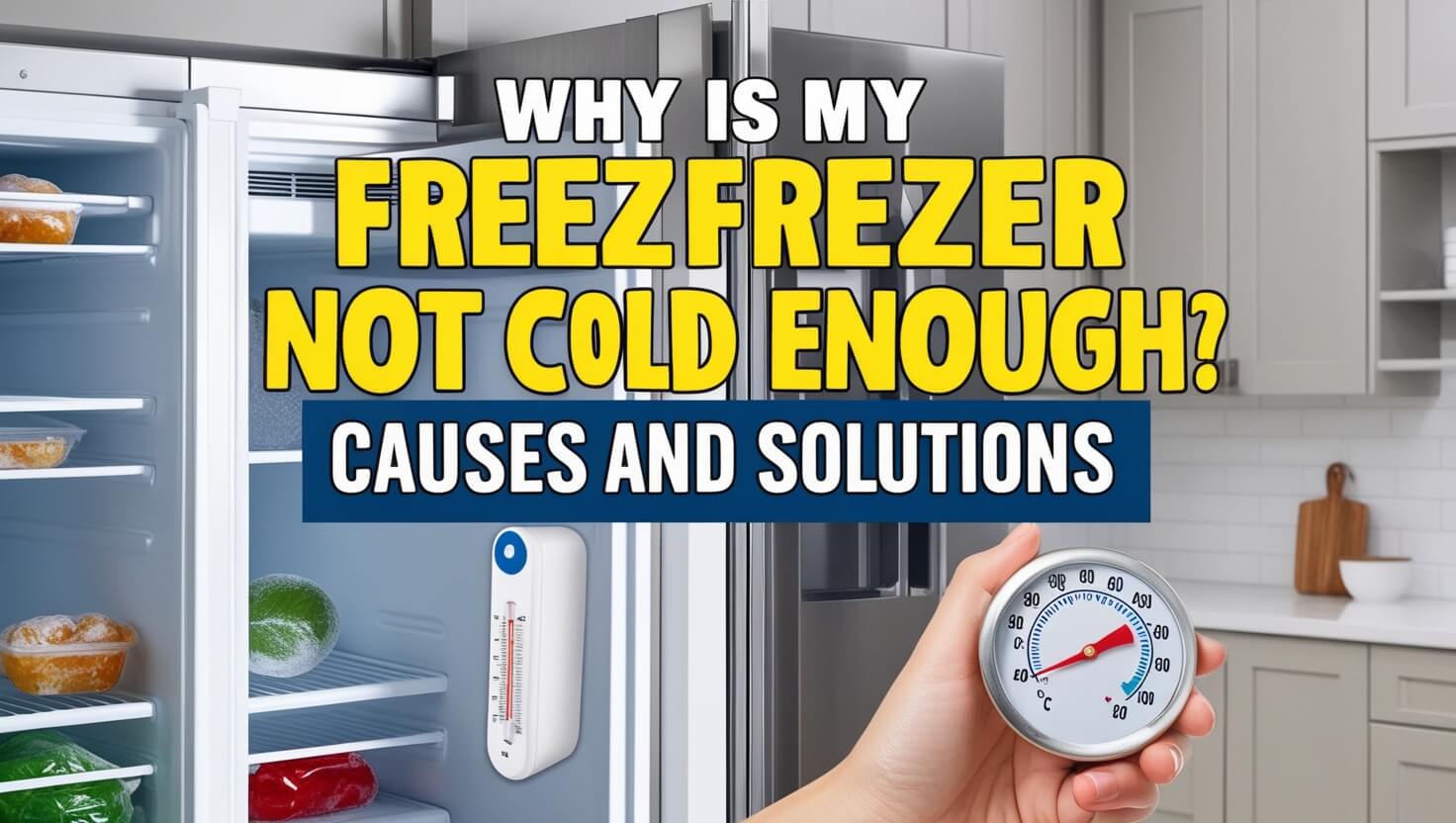
Is your ice cream softer than usual? Are your frozen vegetables thawing faster than they should? You might be dealing with a freezer that’s not cold enough. The ideal freezer temperature is 0°F (-18°C). If your freezer isn’t maintaining this temperature, it’s time to investigate the cause and find a solution.
In this comprehensive guide, we’ll explore the reasons behind a freezer that’s not cold enough and provide practical solutions to get your freezer back to its optimal freezing performance. From simple fixes you can do yourself to knowing when it’s time to call in the professionals, we’ve got you covered.
Freezer Temperature
Ideal Freezer Temperature
Your freezer should be a winter wonderland, keeping everything inside icy cold. The magic number for freezer temperature is 0°F (-18°C). At this temperature, food stays frozen solid, preserving its quality and preventing bacterial growth.
Signs Your Freezer Isn’t Cold Enough
How can you tell if your freezer’s not living up to its chilly reputation? Here are some telltale signs:
- Soft ice cream
- Frost or ice crystals on food packages
- Meat thawing faster than usual
- Ice cubes melting or sticking together
If you notice any of these signs, it’s time to dig deeper into why your freezer’s not cold enough.
Common Causes of a Freezer Not Getting Cold Enough
Overpacking and Poor Air Circulation
Think of your freezer like a crowded room. If it’s too packed, air can’t move around freely. This poor circulation can lead to warm spots and uneven cooling. The fix? Give your frozen foods some breathing room. Aim to keep your freezer about 70-85% full for optimal performance.
Dirty Condenser Coils
Condenser coils are like the lungs of your freezer. They help release heat, allowing the freezer to cool down. When these coils get caked with dust and dirt, they can’t do their job properly. The result? A freezer that’s not cold enough to keep your ice cream solid.
Faulty Door Seal
A damaged or dirty door seal (also called a gasket) is like leaving your freezer door slightly open all the time. Cold air escapes, and warm air sneaks in. This constant battle makes your freezer work overtime, often without success.
Frost Buildup
While a little frost is normal, excessive buildup can act like a warm, fuzzy blanket on your freezer’s cooling elements. This insulation prevents your freezer from reaching its coldest potential.
Malfunctioning Thermostat
The thermostat is your freezer’s brain. It tells the cooling system when to kick in and when to take a break. If it’s not working right, your freezer might think it’s cold enough when it’s actually on the warm side.
Evaporator Fan Issues
The evaporator fan is responsible for circulating cold air throughout your freezer. If it’s not spinning as it should, you might end up with a freezer that’s not cold enough, even if the cooling system is working.
Compressor Problems
The compressor is the heart of your freezer’s cooling system. It pumps refrigerant through the coils, creating the cold temperatures you need. A failing compressor can lead to a freezer that’s struggling to stay cold.
Refrigerant Leaks
Refrigerant is the lifeblood of your freezer’s cooling system. If it’s leaking, your freezer won’t be able to generate enough cold air to keep things frozen.
Troubleshooting a Freezer That’s Not Cold Enough
Now that we’ve covered the common culprits, let’s roll up our sleeves and get to work on fixing that warm freezer.
Check the Temperature Settings
First things first, let’s make sure your freezer is set to the right temperature. Find the temperature control (usually inside the freezer or on the front panel) and set it to 0°F (-18°C). Give it 24 hours to stabilize before checking again.
Inspect and Clean the Door Seal
Run your hand around the edge of the freezer door. Feel any warm air sneaking in? That’s a sign of a faulty seal. Clean the seal with warm, soapy water and dry it thoroughly. If it’s torn or damaged, it’s time for a replacement.
Organize and Declutter Your Freezer
Channel your inner Marie Kondo and give your freezer a makeover. Remove everything and only put back what you need. Organize items so there’s space between them for air to circulate. Your freezer will thank you by staying nice and cold.
Clean the Condenser Coils
Time to give those condenser coils a spa day. Unplug your freezer and locate the coils (usually on the back or underneath). Use a vacuum with a brush attachment to gently remove dust and debris. For stubborn dirt, a soft brush can help. Clean coils mean a happier, colder freezer.
Defrost Manual Freezers
If you have a manual defrost freezer, regular defrosting is key to keeping it cold enough. When frost buildup reaches 1/4 inch thick, it’s time to defrost. Unplug the freezer, remove all food, and let the frost melt. Speed up the process with bowls of hot water, but never use sharp objects to chip away at the ice.
When to Call a Professional
While many freezer issues can be DIY fixes, some problems require expert hands. Here’s when to pick up the phone and call a pro:
Complex Issues Requiring Expert Help
If you’ve tried the troubleshooting steps above and your freezer’s still not cold enough, it might be time for professional help. Issues with the compressor, refrigerant leaks, or electrical problems are best left to trained technicians.
Signs of Major Appliance Failure
If your freezer is making strange noises, leaking water, or showing other signs of distress along with temperature issues, it could indicate a major problem. A professional can diagnose and fix the issue, potentially saving you from a complete freezer meltdown.
Preventing Future Freezer Temperature Issues
An ounce of prevention is worth a pound of cure, especially when it comes to keeping your freezer cold enough. Here are some tips to keep your freezer in top shape:
Regular Maintenance Tips
- Clean the condenser coils every 6 months
- Check and clean the door seal regularly
- Defrost manual freezers before frost buildup reaches 1/4 inch
- Keep a freezer thermometer inside to monitor temperature
Best Practices for Freezer Use
- Don’t overpack your freezer
- Cool hot foods before freezing
- Minimize how often and how long you keep the freezer door open
- Keep your freezer at least 70% full for optimal efficiency
Is It Time to Replace Your Freezer?
Sometimes, no matter how much TLC you give your freezer, it might be time to say goodbye and welcome a new, more efficient model.
Age and Efficiency Considerations
Most freezers last between 10 to 20 years. If yours is approaching this age and struggling to stay cold, it might be more cost-effective in the long run to replace it. Newer models are often more energy-efficient, which can save you money on electricity bills.
Cost of Repairs vs. Replacement
If the cost of repairing your freezer is more than half the price of a new one, replacement might be the better option. Consider the age of your freezer, the frequency of repairs, and the potential energy savings of a new model when making your decision.
Keeping Your Freezer at Optimal Temperature
A freezer that’s not cold enough can be frustrating, but with the right knowledge and a bit of elbow grease, you can often solve the problem. Remember, the key to a happy freezer is regular maintenance, proper use, and prompt attention to any issues that arise.
By following the tips and troubleshooting steps in this guide, you can ensure your freezer stays cold enough to keep your food safely frozen. Whether it’s a simple fix like reorganizing your freezer contents or a more complex issue requiring professional help, addressing the problem promptly will help extend the life of your appliance and keep your frozen foods in perfect condition.
Don’t let a warm freezer get you down. With a little know-how and some preventive care, you can keep your freezer running smoothly and your frozen treats perfectly chilled. Here’s to cold freezers and happy frozen food!






